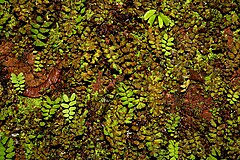Pteridaceae
| Pteridaceae | |
|---|---|

| |
| Pityrogramma austroamericana | |
| Scientific classification | |
| Kingdom: | |
| Division: | |
| Class: | |
| Order: | |
| Family: | Pteridaceae E.D.M.Kirchn.[1]
|
| Subfamilies | |
| Synonyms | |
|
Acrostichaceae A.B.Frank | |

Pteridaceae is a large family of ferns in the order Polypodiales.[2] Members of the family have creeping or erect rhizomes and are mostly terrestrial or epipetric (growing on rock). The leaves are almost always compound and have linear sori that are typically on the margins of the leaves and lack a true indusium, typically being protected by a false indusium formed from the reflexed margin of the leaf. The family includes four groups of genera that are sometimes recognized as separate families: the adiantoid, cheilanthoid, pteroid, and hemionitidoid ferns. Relationships among these groups remain unclear, and although some recent genetic analyses of the Pteridales suggest that neither the family Pteridaceae nor the major groups within it are all monophyletic, as yet these analyses are insufficiently comprehensive and robust to provide good support for a revision of the order at the family level.
Traditional groups

As traditionally defined, the groups within Pteridaceae are as follows:
- Adiantoid ferns (tribe Adianteae Gaudich. 1829[3]); epipetric, terrestrial or epiphytic in moist habitats, rachis often dichotomously branching; sori relatively small and discrete with sporangia born on the false indusium rather than the leaf blade proper; only one genus:
- Cheilanthoid ferns; primarily epipetric in semiarid habitats; leaves mostly with well-developed scales or trichomes, often bipinnate or otherwise highly compound; sporangia mostly born in marginal sori with false indusia that are +/- continuous around the leaf margins; several genera, including:
- Argyrochosma (J.Sm.) Windham – false cloak ferns
- Aspidotis (Nutt. ex Hook.) Copel. – lace ferns
- Astrolepis D.M.Benham & Windham – cloak ferns
- Cheilanthes Sw. – lip ferns
- Notholaena R.Br. – cloak ferns
- Pellaea Link – cliff brakes[4][5]
- Pteridoid ferns (tribe Pterideae J. Sm 1841[6]); terrestrial and epipetric in moist habitats; leaves mostly without prominent scales or trichomes, most often pinnate but sometimes more compound; sporangia born in marginal sori with false indusia that are +/- continuous around the leaf margins; several genera, including:
- Parkerioid ferns (tribe Parkerieae Brongn. 1843[7]); aquatic in swamps and/or mangroves, including:
- Acrostichum L. – leather ferns
- Ceratopteris Brongn.[4][5]
- Hemionitidoid ferns; terrestrial, epipetric or epiphytic in moist or semiarid habitats; leaves simple, pinnate, or more compound; sporangia born in linear non-marginal, exindusiate sori or sometimes in marginal sori; several genera, including:
- Anogramma Link
- Cryptogramma R.Br. – rock brakes
- Eriosorus Fée
- Hemionitis L.
- Jamesonia Hook. & Grev.
- Pityrogramma Link – gold ferns[4][5]
- Vittarioid ferns (tribe Vittarieae C. Presl 1836[8]); primarily epiphytic in tropical regions and all have simple leaves with sori that follow the veins and lack true indusia:
- Anetium Splitg. 1840
- Antrophyum Kaulf. 1875
- Hecistopteris (L.) Sm. 1842
- Monogramma Comm. ex Schkuhr 1809
- Vittaria (L.) Sm. 1793 – Shoestring fern
Subfamilies
Based on phylogenetic research, Christenhusz et al. (2011) divided the Pteridaceae genera into the following subfamilies.[2] These roughly correspond with the groups listed above, with the main difference being that adiantoid and vittarioid ferns are combined under the Vittarioideae subfamily name.
- Cryptogrammoideae S.Linds. 2009
- Genera: Coniogramme, Cryptogramma, Llavea
- Ceratopteridoideae (J.Sm.) R.M.Tryon 1986
- Genera: Acrostichum, Ceratopteris
- Pteridoideae C.Chr. ex Crabbe, Jermy & Mickel 1975
- Genera: Actiniopteris, Anogramma, Aspleniopsis, Austrogramme, Cerosora, Cosentinia, Jamesonia (incl. Eriosorus), Nephopteris, Onychium, Pityrogramma, Pteris (incl. Neurocallis & Platyzoma), Pterozonium, Syngramma, Taenitis
- Cheilanthoideae W.C.Shieh 1973
- Genera: Adiantopsis, Aleuritopteris, Argyrochosma, Aspidotis, Astrolepis, Bommeria, Calciphilopteris, Cassebeera, Cheilanthes, Cheiloplecton, Doryopteris, Hemionitis, Mildella, Notholaena, Paraceterach, Paragymnopteris, Pellaea, Pentagramma, Trachypteris, Tryonella
- Vittarioideae (C.Presl) Crabbe, Jermy & Mickel 1975
- Genera: Adiantum, Ananthacorus, Anetium, Antrophyum, Haplopteris, Hecistopteris, Monogramma, Polytaenium, Radiovittaria, Rheopteris, Scoliosorus, Vittaria
Phylogenic relationships
The following phylogram, showing the relationships between the subfamilies listed above, is based on Schuettpelz & Pryer (2008).[9][10]
References
- ^ a b "Family: Pteridaceae E. D. M. Kirchn". Germplasm Resources Information Network. United States Department of Agriculture. 2001-08-14. Retrieved 2011-11-04.
- ^ a b Christenhusz, Maarten J. M.; Zhang, Xian-Chun; Schneider, Harald (18 February 2011). "A linear sequence of extant families and genera of lycophytes and ferns" (PDF). Phytotaxa. 19: 7–54. ISSN 1179-3163.
- ^ Adianteae Tropicos.org. Missouri Botanical Garden. 14 Jan 2012
- ^ a b c d e "Pteridaceae". Integrated Taxonomic Information System. Retrieved 2011-11-04.
- ^ a b c d e "GRIN Genera of Pteridaceae". Germplasm Resources Information Network. United States Department of Agriculture. Retrieved 2011-11-04.
- ^ Pterideae Tropicos.org. Missouri Botanical Garden. 14 Jan 2012
- ^ Parkerieae Tropicos.org. Missouri Botanical Garden. 14 Jan 2012
- ^ Vittarieae Tropicos.org. Missouri Botanical Garden. 14 Jan 2012
- ^ Schuettpelz & Pryer (2008) "Fern phylogeny" in Biology and Evolution of Ferns and Lycophytes, ed. Tom A. Ranker and Christopher H. Haufler. Cambridge University Press 2008
- ^ Schuettpelz et al. (2007) Eric Schuettpelz, Harald Schneider, Layne Huiet, Michael D. Windham, Kathleen M. Pryer: "A molecular phylogeny of the fern family Pteridaceae: Assessing overall relationships and the affinities of previously unsampled genera." Molecular Phylogenetics and Evolution 44 (2007) 1172–1185
External links
![]() Data related to Pteridaceae at Wikispecies
Data related to Pteridaceae at Wikispecies
